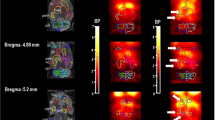Abstract
CD-1 mice received single intraperitoneal (IP) doses of caffeine-sodium benzoate (caffeine doses: 0, 20 and 40 mg/kg) followed by injections of alprazolam-propylene glycol (0, 0.05, and 2 mg/kg, IP) to determine brain concentrations, effects on in vivo receptor binding of a specific high-affinity benzodiazepine receptor ligand [3H]Ro15-1788, and effects on motor activity over a 1-h period. A behavioral monitoring device, using infrared sensors, measured horizontal and ambulatory activity. Caffeine produced significant increases in all motor activity measures as compared to vehicle treatment, with low dose caffeine (with brain concentrations of 13 µg/g) stimulating activity to a greater degree than the high dose (with brain concentrations of 30 µg/g). The overall effect of caffeine on benzodiazepine receptor binding was not significant. Alprazolam significantly diminished motor activity and altered benzodiazepine receptor binding. Low dose alprazolam increased binding, while the high dose diminished it. Caffeine and alprazolam antagonized each other's behavioral effects in this study, but did not alter each other's uptake into brain. Alprazolam's antagonism of caffeine-induced motor stimulation was associated with decreases in receptor binding, whereas caffeine's reversal of alprazolam-induced motor depression was not associated with any changes in binding. The lack of a clear association between drug effects on benzodiazepine binding and on motor activity suggests that behavioral effects of caffeine and alprazolam may be mediated by other sites in addition to the benzodiazepine receptor.
Similar content being viewed by others
References
Boulenger J-P, Patel J, Post RM, Parma AM, Marangos PJ (1983) Chronic caffeine consumption increases the number of brain adenosine receptors. Life Sci 32:1135–1142
Buckholtz NS, Middaugh LD (1987) Effects of caffeine and L-phenylisopropyladenosine on locomotor activity of mice. Pharmacol Biochem Behav 28:179–185
Daly JW, Bruns RF, Snyder SH (1981) Adenosine receptors in the central nervous system: relationship to the central actions of methylxanthines. Life Sci 28:2083–2097
File SA, Bond AJ, Lister RG (1982) Interaction between effects of caffeine and lorazepam in performance tests and self-ratings. J Clin Psychopharmacol 2:102–106
Fredholm BB, Dunwiddie TV (1988) How does adenosine inhibit transmitter release? TIPS 9:130–134
Ghoneim MM, Hinrichs JV, Chiang C-K, Loke WH (1986) Pharmacokinetic and pharmacodynamic interactions between caffeine and diazepam. J Clin Psychopharmacol 6:75–80
Greenblatt DJ, Divoll M, Shader RI (1983) Automated gas chromatographic determination of plasma alprazolam concentrations. J Clin Psychopharmacol 3:366–368
Hawkins M, Pravica M, Radulovacki M (1988) Chronic administration of diazepam downregulates adenosine receptors in the rat brain. Pharmacol Biochem Behav 30:303–308
Hollins C, Stone TW (1980) Adenosine inhibition of γ-aminobutyric acid release from slices of rat cerebral cortex. Br J Pharmacol 69:107–112
Kaplan GB, Greenblatt DJ, LeDuc BW, Thompson ML, Shader RI (1989) Relationship of plasma and brain concentrations of caffeine and metabolites to benzodiazepine receptor binding and locomotor activity. J Pharmacol Exp Ther 248:1078–1083
Kaplan GB, Tai NT, Greenblatt DJ, Shader RI (1990) Relationship of caffeine pharmacokinetics to behavioral pharmacodynamics. Br J Pharmacol (in press)
Kennedy JS, LeDuc BW, Scavone JM, Harmatz JS, Shader RI, Greenblatt DJ (1987) Pharmacokinetics of intravenous caffeine: comparison of high-performance liquid chromatographic and gas chromatographic methods. J Chromatogr 422:274–280
Loke WH, Hinrichs JV, Ghoneim MM (1985) Caffeine and diazepam: separate and combined effects on mood, memory, and psychomotor performance. Psychopharmacology 87:344–350
Marangos PJ, Paul SM, Parma AM, Goodwin FK, Syapin P, Skolnick P (1979) Purinergic inhibition of diazepam binding to rat brain (in vitro). Life Sci 24:851–858
Marangos PJ, Martino AM, Paul SM, Skolnick P (1981) The benzodiazepines and inosine antagonize caffeine-induced seizures. Psychopharmacology 72:269–273
Mattila MJ, Palva E, Savolainen K (1982) Caffeine antagonizes diazepam effects in man. Med Biol 60:121–123
Miller LG, Greenblatt DJ, Barnhill JG, Deutsch SI, Shader RI, Paul SM (1987a) Benzodiazepine receptor binding of triazolobenzodiazepines in vivo: increased receptor number with low-dose alprazolam. J Neurochem 49:1595–1601
Miller LG, Greenblatt DJ, Paul SM, Shader RI (1987b) Benzodiazepine receptor occupancy in vivo: correlation with brain concentrations and pharmacodynamic actions. J Pharmacol Exp Ther 240:516–522
Phillis JW, O'Regan MH (1988) Benzodiazepine interaction with adenosine systems explains some anomalies in GABA hypothesis. TIPS 9:153–154
Polc P, Bonetti EP, Piere L, Cumin R, Angioi RM, Möhler H, Haefely WE (1981) Caffeine antagonizes several central effects of diazepam. Life Sci 28:2265–2275
Roache JD, Griffiths RR (1987) Interaction of diazepam and caffeine: behavioral and subjective dose effects in humans. Pharmacol Biochem Behav 26:801–812
Roca DJ, Schiller GD, Farb DH (1988) Chronic caffeine or theophylline exposure reduces γ-aminobutyric acid/benzodiazepine receptor site interactions. Mol Pharmacol 30:481–485
Thithapandha A, Maling HM, Gilette JR (1982) Effects of caffeine and theophylline on activity of rats in relation to brain xanthine concentrations. Proc Soc Exper Biol Med 139:582–586
Vellucci SV, Webster RA (1984) Antagonism of caffeine-induced seizures in mice by Ro15-1788. Eur J Pharmacol 97:289–293
Weir RL, Hruska RE (1983) Interaction between methylxanthines and the benzodiazepine receptor. Arch Int Pharmacodyn 265:42–48
Wu PH, Coffin VL (1984) Up-regulation of brain [3H]diazepam binding sites in chronic caffeine-treated rats. Brain Res 294:186–189
Author information
Authors and Affiliations
Additional information
Supported in part by Grants MH-34223, AG-00106, and DA-05258 from the Department of Health and Human Services
Rights and permissions
About this article
Cite this article
Kaplan, G.B., Tai, N.T., Greenblatt, D.J. et al. Separate and combined effects of caffeine and alprazolam on motor activity and benzodiazepine receptor binding in vivo. Psychopharmacology 101, 539–544 (1990). https://doi.org/10.1007/BF02244234
Received:
Revised:
Issue Date:
DOI: https://doi.org/10.1007/BF02244234




